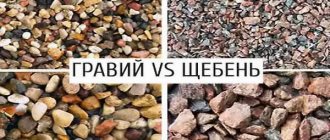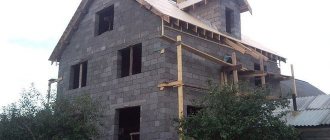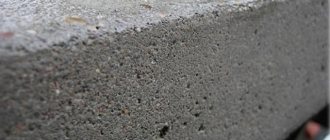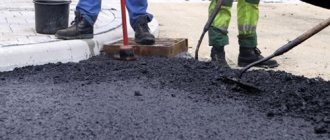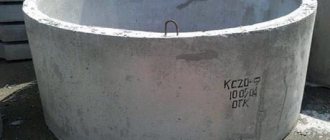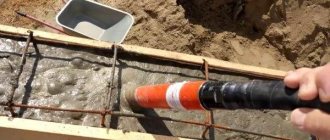The term “crushed gravel” refers to non-metallic bulk building materials obtained by sifting rock or gravel, or by crushing rocks and boulders. In terms of strength and frost resistance, this variety is inferior to granite crushed stone, but outperforms dolomite and slag. The same applies to cost; gravel screenings and fractions occupy an intermediate position; they are often used as a budget alternative to high-strength grades. The main scope of application includes the production of concrete and reinforced concrete products, foundation and road work, some types are suitable for decoration and landscaping.
Specifications
Crushed stone of this type not only has good qualities, but also meets a number of important characteristics in accordance with GOST 8267 93:
- Rock strength M800 - M1000;
- Flakiness (particle shape) - 7 - 17%. One of the most important characteristics. The most preferred shape is cuboid, since flat particles will not fit tightly together. This makes it possible to reduce the density of the embankment;
- Density - 2400 m/kg3;
- Frost resistance F150. Withstands up to 150 periods of thawing and freezing;
- Class 1 radioactivity. This means that crushed gravel is not only unable to emit it, but also absorb it. This characteristic is an order of magnitude higher than that of the granite type of crushed stone;
- Weak breeds make up 1.5% or less;
- Do not have foreign harmful impurities;
- Clay and other dust particles occupy only 0.6% of the total strength. This allows us to talk about the best susceptibility to binding materials;
- The bulk density of different fractions, as a rule, does not differ. Usually it is about 1.3 tons, but it is possible less, since this characteristic will depend on the origin or place of its extraction.
DIY gravel paths
Recently, the main area where gravel is still widely used is the arrangement of the territories of country houses and dachas, or as it is now fashionably called - in landscape design. Everyone can show their talent as a designer using gravel of various types, sizes and colors. Building an alpine slide or a previously unseen structure made of stone is as simple as painting an oil painting, but making a decorative platform or laying comfortable paths around the adjacent territory of a country house is not as easy as it might seem at first glance, but everyone can do it - there would be a desire.
Independent construction of paths made of gravel stones or pebbles can be divided into several stages, the observance of which will allow you to consistently and without extra costs realize your ideas and surprise others with your talent. And so, let's get started:
- The first stage or preparation. Here it is necessary to make a sketch on paper of future decorative areas, paths and other planned landscape elements.
- At the second stage, using a tape measure, pegs and ropes, we mark the location of future construction projects in strict accordance with the developed sketch, or, if necessary, we make adjustments to the landscaping plan for your territory.
- At the third stage, after all the boundaries are defined and outlined, all the pegs are placed and all the ropes are pulled, we proceed directly to the implementation of the plan. Under all future paths and areas, we use a shovel to remove the fertile layer of soil, which, as a rule, is no more than 15 cm. This will save you from weeds and grass for a certain period of time. The resulting soil can simply be spread evenly over existing lawns or stored somewhere for future flower beds.
- At the next stage, we fill the bottom of the resulting trenches and depressions and carefully compact them with coarse gravel or crushed stone; you can also use solid construction waste from fragments of bricks and concrete. The volume of fill should be approximately one-half to two-thirds the depth of the excavated hole. After compaction, to increase strength, we spill the resulting base with water. It is not recommended to sprinkle the bases of paths and platforms with clay; it is necessary to exclude the possibility of accumulation of large masses of water during rain or heavy melting of snow.
- Next, a layer of purchased or prepared decorative gravel is poured onto the prepared base. Be sure to use gravel or pebbles of various colors when filling paths, which will greatly diversify the overall appearance of the landscape. It is also necessary to level and moderately compact the completed surfaces.
- The final completion will be the mandatory design of the entire landscape design. Here you can use various stones, flower beds and other decorative little things or designer fakes.
Now you can enjoy the results of your work and rejoice at the beautiful design of the surrounding area of your country house.
And in conclusion, we suggest watching a video with original ideas for designing paths made of pebbles:
Technical characteristics of granite crushed stone
Granite crushed stone is crushed stone produced from granite rock with a granular structure. Granite rock is made up of magma that is brought to the surface of the earth and hardened.
Main technical characteristics of granite crushed stone:
Fractional composition - the dimensions that are acceptable for crushed granite are as follows: 0-5 mm - this is the smallest granite screening used for decorative finishing; from 5 to 20 mm – fine fraction, which is used for the production of concrete and concrete structures; from 20 to 40 mm – the middle fraction, which is used for the production of reinforced concrete structures; from 20 to 70 mm – coarse fraction, which is used for the production of massive concrete structures; from 70 to 300 mm - rarely used, mainly for decorative finishing of reservoirs and swimming pools.
Strength is the ultimate strength, rock wear and crushability during compression - the permissible value is 800-1600 kgf/cm2, i.e. granite crushed stone is durable and highly durable.
Frost resistance - the number of freezing and thawing cycles for granite crushed stone is 300-400.
Flakiness - granite crushed stone consists of 5-23% lamellar (flaky) grains.
Adhesion - determined by visual inspection of the material; the darker the color, the higher this indicator.
Radioactivity is an important characteristic of crushed stone. Determined by the conclusion of the sanitary-epidemiological service. The radioactivity of crushed granite is no more than 370 Bq/kg.
Content of dust and clay particles
Dust and clay particles are inclusions whose size does not exceed 0.05 mm. They surround larger grains with a dense shell, reducing adhesion. This negatively affects, for example, the quality of concrete solutions. These particles also swell upon contact with water, affecting the overall volume and mass of the rock. In other words, the lower the content of these inclusions, the better.
Most of the dust and clay particles are in the mountain variety of gravel. Therefore, such material must be thoroughly washed before use. The content of these inclusions in sea or river gravel is usually minimal. This is due to the fact that the raw materials are washed with powerful jets of water, clearing them of foreign impurities.
Requirements for the permissible content of dust and clay particles are imposed on gravel:
| Brand | Maximum permissible content of dust and clay particles |
| M400 | 3% |
| M600 | 2% |
| M800 | 1% |
| M1000 |
Technical characteristics of crushed limestone
Crushed limestone is formed from calcium carbonate. This crushed stone is also called dolomite crushed stone. Limestone crushed stone is used for construction along with other types of crushed stone.
Main technical characteristics of crushed limestone:
Fractional composition - limestone crushed stone is produced in three fractions of the following sizes: 5-20 mm, 20-40 mm and 40-70 mm.
Strength – for the construction of roads with light traffic loads, limestone crushed stone with a strength of 200 kg/cm2 is used. For the construction of roads with average transport activity, dolomite crushed stone with a strength of 300 to 600 kg/cm2 is used. For industrial roads, crushed limestone with a strength of 600 to 800 kg/cm2 is used.
Frost resistance is a number that determines the number of freezing and thawing cycles; crushed limestone is 300.
Adhesion - determined by visual inspection of the material; the darker the color, the higher this indicator.
Radioactivity is an important characteristic of crushed stone. Determined by the conclusion of the sanitary-epidemiological service. The radioactivity of crushed limestone is no more than 370 Bq/kg.
Links[edit]
- "1 Kwame Nkrumah University of Science and Technology" (PDF). 1Kwame Nkrumah University of Science and Technology
. - Jump up
↑ Freeze, R. Allan (1979). The groundwater . Cherry, John A. Englewood Cliffs, NJ: Prentice-Hall. ISBN 0-13-365312-9. OCLC 4493153. - Mineral Commodity Briefs 2006 2009
- Industrial sand and gravel (silica): global production, by country, 2009.
- Collins English Dictionary - Complete and Unabridged 11th Edition. Retrieved August 30, 2012, from CollinsDictionary.com: https://www.collinsdictionary.com/dictionary/english/gravel
- Gravel, n., Oxford English Dictionary,
Second Edition on CD (Version 4.0) © Oxford University Press 2009. - "gravel". 1828 Noah Webster's American Dictionary of the English Language. 2015. https://1828.mshaffer.com/d/word/gravel (January 8, 2015)
- "Gravel, n." def. 1. Whitney, William Dwight. Dictionary of the Century; Encyclopedic lexicon of the English language. Vol. 3. New York: Centennial, 1889. 2607. Print.
- "Quarry Process - QP, DGA - NJ, NY, NYC, PA". www.braenstone.com
. - C.Michael Hogan. 2010. Abiotic factor. Encyclopedia of the Earth. editors Emily Monosson and K. Cleveland. National Science and Environment Council. Archived June 8, 2013, at the Wayback Machine. Washington, DC
Scope of application
The functional purpose depends on the variety; gravel allows you to quickly and inexpensively arrange a garden path, flower bed or area. In this case, the smoothness of the walls is not a disadvantage, but an advantage; people can safely walk on round pebbles. Rocks from different quarries differ in color; this property is positively assessed by landscape designers. But the main area of use of this material is still construction: 1. Gravel screenings (0-5 mm), in addition to landscaping work, are used for the manufacture of certain brands of concrete and road topping; they are rarely found on sale.
2. It is recommended to buy a fine fraction (3-10 mm) for preparing a solution for self-leveling floors and pouring a foundation. 3. 5-10 mm - a popular grade, used in the manufacture of concrete for foundations, loaded structures and other types of reinforced concrete products. 4. Crushed stone fraction 20-40 mm (medium) - the same, plus drainage work. The disadvantage is the possible content of quarry sand; this grade is most often seeded. 5. Coarse fraction (40-70 mm) – repair, road and drainage work, concreting and strengthening of massive structures. Rarely found on public sale. In addition to a slight concession in strength, the differences between gravel and granite crushed stone include a reduced background of radioactivity, as a result, this variety is indispensable in the construction of civil structures; it is recommended to be chosen by developers of private houses. Due to its more affordable price, it is often considered as an alternative to high-strength brands, but the admissibility of such a replacement is trusted exclusively to specialists.
The cleanliness of crushed stone plays an important role: washed crushed stone is used almost without restrictions, dry cleaned is not suitable for all concrete, its use extends the work time due to the need for additional preparation.
Kinds
The origin determines the types of gravel:
Mountain. Its formation occurs during the destruction of rocks. Has a rough surface. It contains a high content of clay, sand, and organic matter.
Sea, river, lake. It is mined in river beds and along coastlines. Characterized by a round, smooth shape. Contains a minimal percentage of impurities. However, due to the clean polished surface, it shows low adhesive properties with any building materials.
Glacial. It has an unrolled rough surface and a homogeneous composition. It is formed due to the movement of masses of ice, pulling rock along with it, causing it to collapse.
Extraction of crushed gravel in quarries
Crushed gravel is mined along with other types of stones in loose sedimentary rock. Since it is initially a monolithic rock, blasting work will be required.
When specialists carry out a series of explosions, the rubble will split into relatively small blocks. Next, they are placed in special crushing equipment, which allows the stone to be crushed into the required fractions.
Once the crushed stone is crushed, it is sifted. This is done using the screening method, which allows you to separate smaller rocks from larger ones. Almost immediately it can be used for various purposes, including construction.
Place of Birth
The largest gravel deposits in the CCCP are located on the terraces, floodplains and beds of the Kama, Pechora, upper and middle reaches of the Yenisei, Irtysh, lower reaches of the Angara, Syrdarya and other rivers, as well as in the aqua-glacial deposits of the north-west of the RSFSR and the BSSR. The largest CCCP quarry producing gravel of the highest quality is Sychevsky (Moscow region). Gravel production in the CCCP increased from 67 million m3 in 1965 to 89.4 million m3 in 1980.
Gravel is mined on a large scale in the USA, Germany, Great Britain and other countries.
Crushed stone fractions
Crushed gravel is divided into fractions. Each of them is used for some primary purpose.
There is the following division:
- up to 5 mm. Gravel screening is usually used for ice prevention or landscaping work, as it is very fine;
- up to 10 mm. The main use is concrete production, landscaping, foundation construction;
- up to 20 mm. Is the most popular. The main use is the production of cement, cement products, foundation construction;
- up to 40 mm. The main use, as in other cases, is foundation work, the production of concrete and concrete products. Additionally required for drainage work;
- up to 70 or up to 90 mm. Necessary for both previous purposes and for decorative purposes. Widely applicable in road construction;
- up to 150 mm. This faction has its own name - BUT. A very rare species, used for decorative purposes, as well as as the main material for finishing ponds, pools, drains or river banks.
Main areas of use
The ease of extraction and the high prevalence of natural gravel make it available for use in various areas.
Most often this material is used for the production of concrete. This is especially true for quarry gravel, the particles of which have an uneven surface and resemble pieces of rock, rather than smooth, rolled pebbles. Such gravel binds better to concrete, which gives the latter high strength. The second condition for using gravel for concrete production is resistance to alkaline environments.
It is also often used in the construction of roads and railways. At the same time, it must satisfy such requirements as strength, mechanical and temperature stability.
The use of gravel for decorating garden plots and flower beds is gaining momentum. The fine fraction of this material is used to fill paths and rest areas. In this case, it is necessary that the gravel grains are smooth and rolled. The variety with larger particles is used to improve the appearance of ponds, flower beds and squares.
Gravel for the garden
